An historic handshake in space took place on Oct. 25, 2007. For the first time, a woman commander aboard the International Space Station, NASA astronaut Peggy A. Whitson, greeted a woman commander of a visiting space shuttle, NASA astronaut Pamela A. Melroy. In the intervening 15 years, women’s representation on space crews increased significantly, aboard the space station, with women present nearly continuously for the past four years, and NASA’s commercial crew vehicles, with women often comprising half the crew. In October 2022, the second time a woman space station commander, Samantha Cristoforetti of the European Space Agency, greeted the woman commander of the arriving SpaceX Crew Dragon vehicle, NASA astronaut Nicole A. Mann, it no longer seemed unusual. These experiences will help NASA land the first woman and the first person of color on the Moon as part of the Artemis program.

The first handshake in space between two women commanders.
STS-120 Commander Pamela A. Melroy, left, and Expedition 16
Commander Peggy A. Whitson meet at the hatch between
the two vehicles.
As of October 2022, 72 women have flown in space. Of these, 44 have worked aboard the International Space Station as long-duration expedition crewmembers, as visitors on space shuttle assembly flights, or as space flight participants on short-duration Soyuz missions. The history of women in space began on June 16, 1963, when the Soviet Union launched cosmonaut Valentina V. Tereshkova on a three-day flight aboard Vostok 6. Nearly 20 years passed before another woman flew in space, Soviet cosmonaut Svetlana Y. Savitskaya, who spent a week aboard the Salyut-7 space station in August 1982. Savitskaya also completed the first spacewalk by a woman while at the station. Ten months later, on June 18, 1983, NASA astronaut Sally K. Ride made history as the first American woman in space, spending six days aboard the space shuttle Challenger during the STS-7 mission.



Left: Soviet cosmonaut Valentina V. Tereshkova just before boarding her Vostok 6 capsule
for her historic spaceflight. Middle: Soviet cosmonaut Svetlana Y. Savitskaya during her
spacewalk outside the Salyut-7 space station in August 1982. Right: NASA astronaut
Sally K. Ride aboard the space shuttle Challenger during the STS-7 mission.
In October 1984, Ride made history again with fellow NASA astronaut Kathryn D. Sullivan as the first two women to fly on a single crew, aboard Challenger’s STS-41G mission. June 1991 marked the first time that three women – NASA astronauts M. Rhea Seddon, Tamara E. Jernigan, and Millie E. Hughes-Fulford – flew in space at the same time during the STS-40 Spacelab Life Sciences 1 mission. Between April 7 and 17, 2010, for the first time four women were in space at the same time. Expedition 23 Flight Engineer Tracy E. Caldwell Dyson had been living and working aboard the space station since April, when STS-131 arrived, with NASA astronauts Dorothy M. “Dottie” Metcalf-Lindenburger and Stephanie D. Wilson and Naoko Yamazaki of the Japan Aerospace Exploration Agency as part of the shuttle crew.


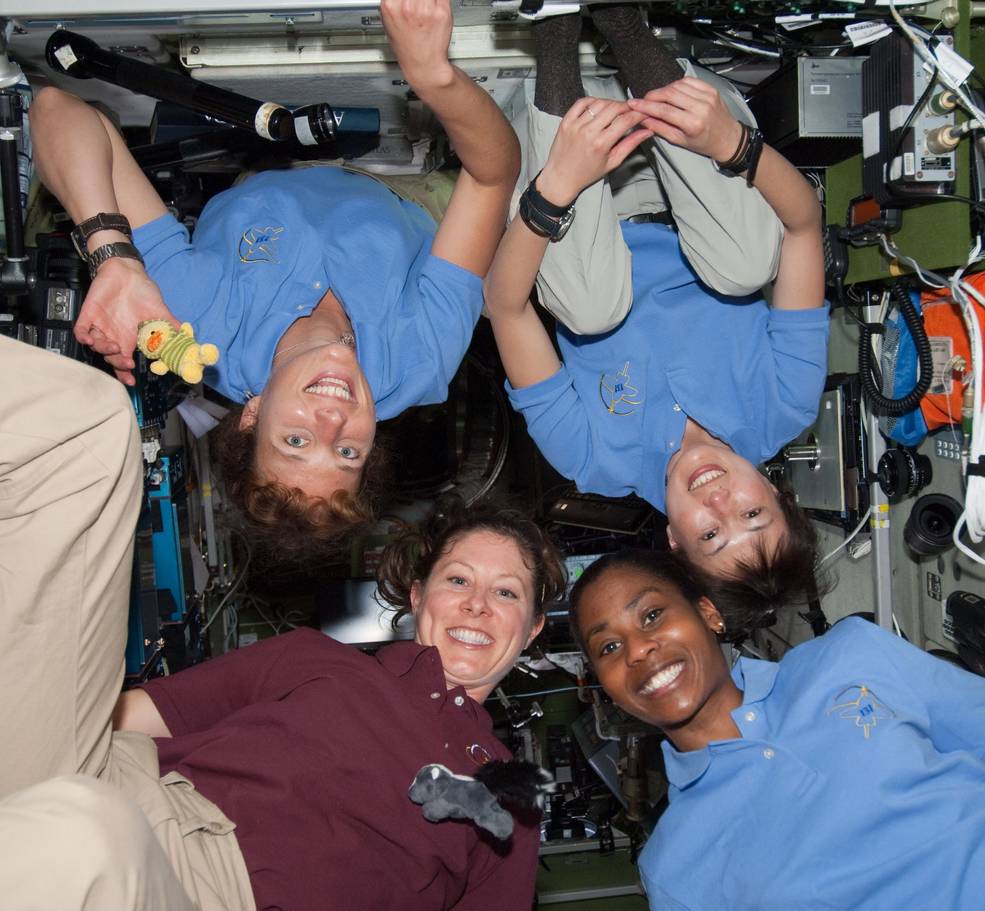
Left: Kathryn D. Sullivan, left, and Sally K. Ride aboard space shuttle Challenger during the
STS-41G mission in 1984. Middle: The first time three women – Tamara E. Jernigan, back row
middle, M. Rhea Seddon, and Millie R. Hughes-Fulford – flew in space together, during the
STS-40 mission in 1991. Right: Four women aboard the International Space Station in
2010 – Dorothy M. Metcalf-Lindenburger, top left, Naoko Yamazaki of the Japan
Aerospace Exploration Agency, Stephanie D. Wilson, and Tracy E. Caldwell Dyson.
The honor of the first woman to complete a long-duration mission in space belongs to Russian cosmonaut Elena V. Kondakova. She launched on Oct. 3, 1994, and spent 169 days aboard the space station Mir as part of Expedition 17, returning to Earth on March 22, 1995. The first American woman to complete a long-duration mission, Shannon W. Lucid launched on March 22, 1996, aboard space shuttle Atlantis. The second astronaut to fly as part of the Shuttle-Mir Program, Lucid spent 188 days aboard Mir as part of Expeditions 21 and 22, returning to Earth on Sept. 26.
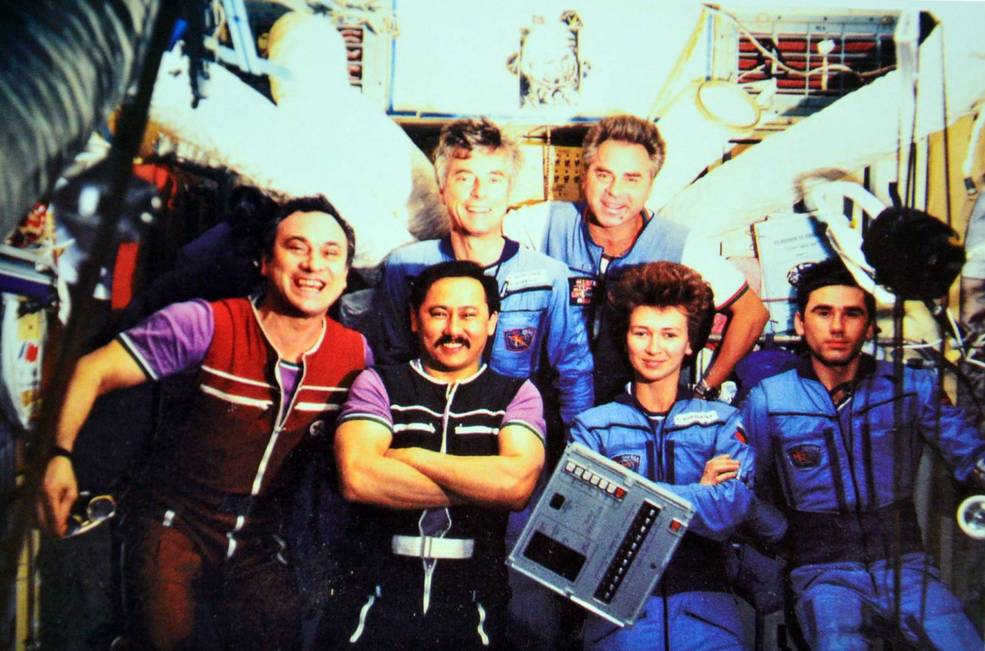

Left: Soviet cosmonaut Elena V. Kondakova, second from right, aboard Mir during
the handover between Expedition 16 and 17 in 1994. Right: NASA astronaut Shannon
W. Lucid, left, with her Mir Expedition 21 crewmates in 1996.
NASA astronaut Eileen M. Collins made history first in February 1995 as the first female pilot of a space shuttle mission on the STS-63 flight to rendezvous with Mir, then in May 1997 as the first woman shuttle pilot to dock with Mir on STS-84, and again in July 1999 as the first woman shuttle commander, on STS-93. In July 2005, Collins became the first woman to command a shuttle mission to the space station, the Return to Flight STS-114 mission, the first after the Columbia accident two years previously. NASA astronaut Pamela A. Melroy served as the first woman pilot on a shuttle flight to the space station, STS-92 in October 2000. She returned to the station as pilot of STS-112 in October 2002 and as commander of STS-120 in October 2007. As a member of Expedition 2, NASA astronaut Susan J. Helms became the first woman to complete a long-duration mission on the space station, a 167-day flight between March and August of 2001. She had previously flown to the station during STS-101, making her the first woman to visit the facility twice.


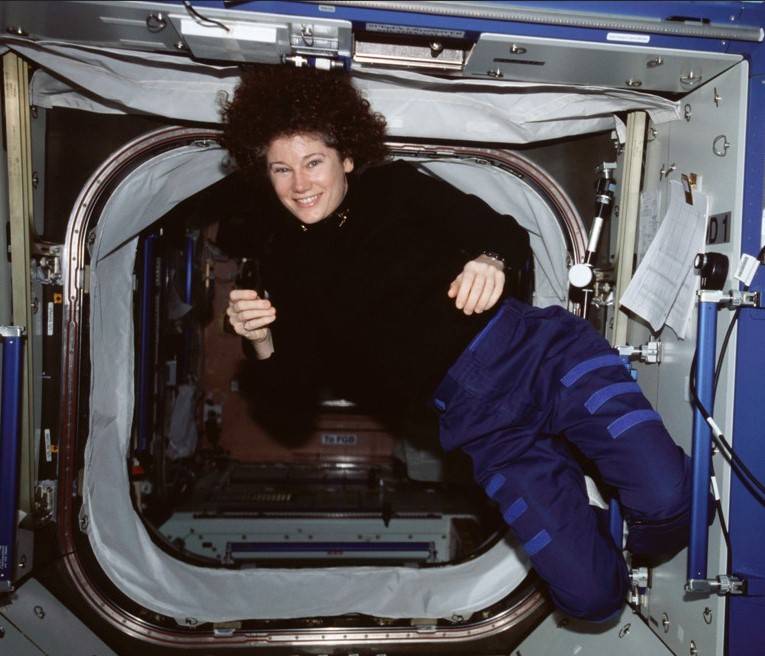
Left: NASA astronaut Eileen M. Collins as pilot of STS-63. Middle: NASA astronaut Pamela D. Melroy
as pilot of STS-92. Right: NASA astronaut Susan J. Helms during Expedition 2.
NASA astronaut Peggy A. Whitson became the first woman commander of the space station during Expedition 16 in 2007, her second long-duration mission to the orbiting lab. During Expedition 16, Whitson welcomed STS-120 Commander Melroy and her crew, marking the first time that commanders of both the space station and the visiting space shuttle were women. In 2017, during Expedition 51 Whitson became the first woman to command the station for a second time. As of October 2022, Whitson holds the record for most cumulative spaceflight time not only for a woman but for any American astronaut. Over the course of three long-duration missions aboard the space station, she spent a total of 665 days or about 1.8 years in space.

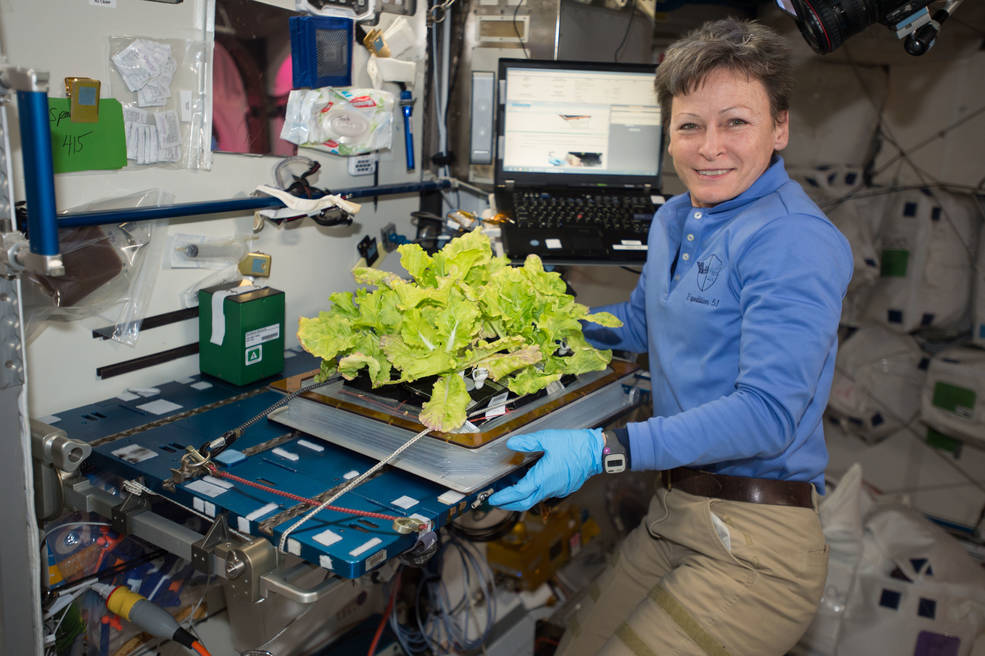
Left: Expedition 16 commander NASA astronaut Peggy A. Whitson, front row second from
left, and STS-120 commander NASA astronaut Pamela D. Melroy, second row second
from left, with their crews. Right: Expedition 51 commander Whitson displaying a
cabbage crop grown aboard the space station.
In June 2010, NASA astronaut Tracy Caldwell Dyson and her two crewmates welcomed a new trio of long-duration crew members including NASA astronaut Shannon Walker, making Expedition 24 the first to include two women. The next two-woman expedition took place between November 2014 and March 2015 – Expedition 42 included Elena O. Serova of Roscosmos, the first Russian woman to make a long-duration flight aboard the space station, and Samantha Cristoforetti from Italy, the first female astronaut from the European Space Agency (ESA) on a long-duration mission. Two women as part of long-duration space station missions are now more commonplace.


Left: Expedition 24 crew members NASA astronauts Douglas Wheelock, left, Tracy
Caldwell Dyson, and Shannon Walker. Right: Expedition 42 crew members Elena
O. Serova of Roscosmos, left, and Samantha Cristoforetti of
the European Space Agency.
Expedition 61 crew members NASA astronauts Christina H. Koch and Jessica U. Meir made history on Oct. 18, 2019, when they floated outside the space station to carry out the first all-woman spacewalk, one of several they conducted to replace the station’s batteries. Meir’s return to Earth marked the end of the longest period of a continuous female presence aboard the space station up to that time – 682 days from June 8, 2018, to April 17, 2020. Six months later, on Oct. 14, 2020, NASA astronaut Kathleen H. “Kate” Rubins arrived aboard the space station as a member of Expedition 64, and since that time at least one woman has served as a member of an expedition crew, with each day that passes setting a new record.


Left: Space suited NASA astronauts Jessica U. Meir, left, and Christina H. Koch,
assisted by their Expedition 61 crewmates, prepare for the first all-woman spacewalk.
Right: NASA astronaut Kathleen H. “Kate” Rubins works on a plant
water management experiment during Expedition 64.
When the SpaceX Crew Dragon Freedom reached orbit on Oct. 5, 2022, Crew 5 included NASA astronaut Mann and cosmonaut Anna Y. Kikina of Roscosmos. With NASA astronaut Jessica A. Watkins and ESA’s Cristoforetti already aboard the International Space Station, and Liu Yang of the People’s Republic of China aboard the Tiangong space station, for the first time in history five women flew in space at the same time.

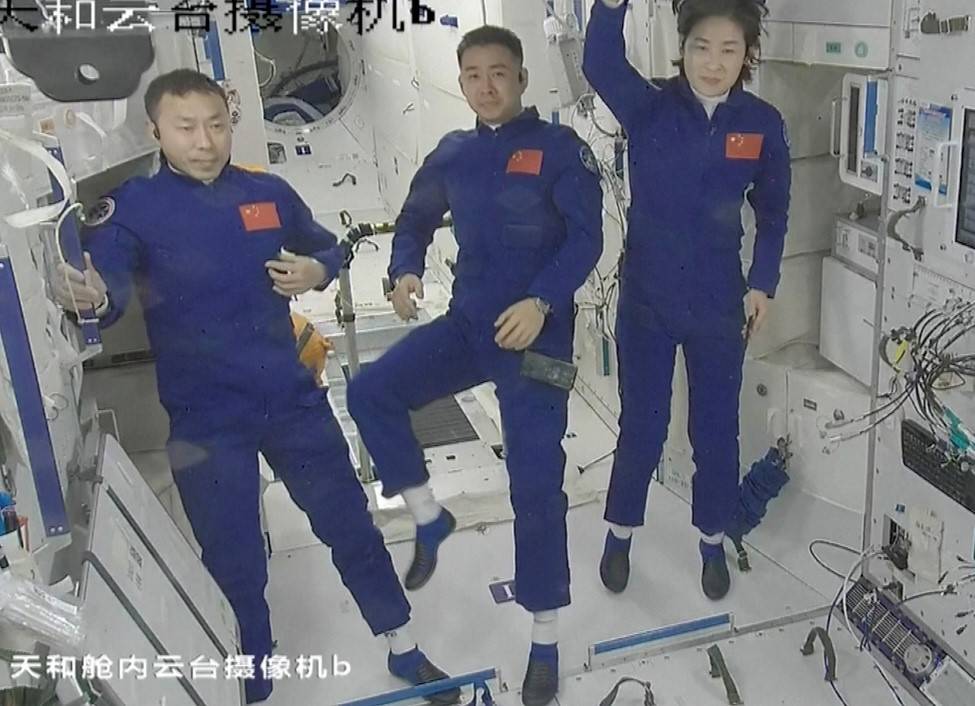
Five women in space at the same time, aboard two space stations, in October 2022.
Left: Anna Y. Kikina, Jessica A. Watkins, Samantha Cristoforetti, and Nicole A. Mann
aboard the International Space Station. Right: Liu Yang, right, aboard
the Chinese Space Station Tiangong.
As noted above, Mann’s arrival at the space station marked the second time two women commanders greeted each other, with station commander Cristoforetti welcoming Crew 5 aboard the orbiting facility. With more women aboard space crews in recent years, the event passed largely unnoticed. These experiences will help NASA to land the first woman on the Moon as part of the Artemis program.

In October 2022, space station commander Samantha Cristoforetti
of the European Space Agency, center holding the microphone,
welcomes SpaceX Crew 5 commander NASA astronaut Nicole
A. Mann, third from right, and her crew.

























